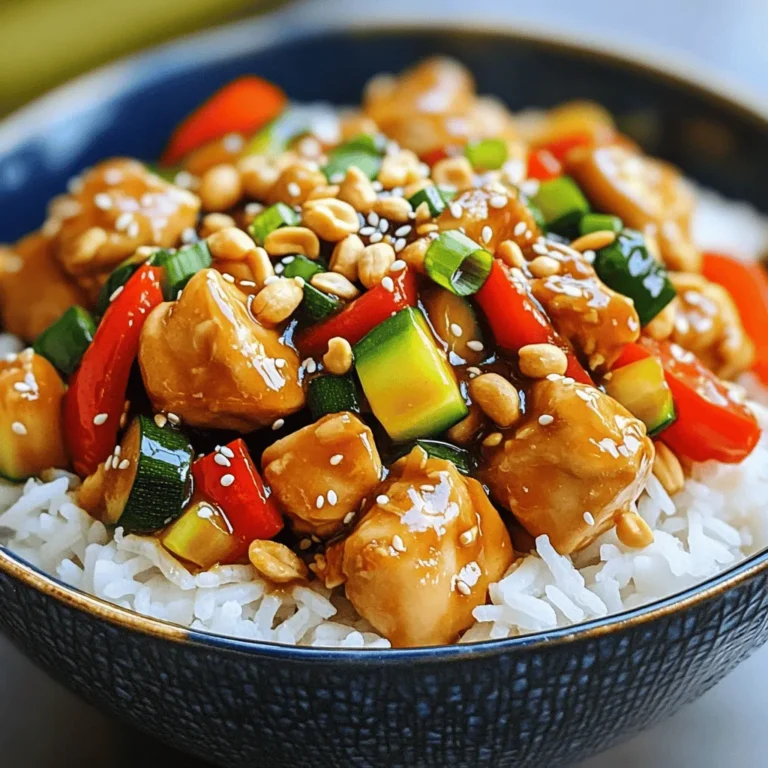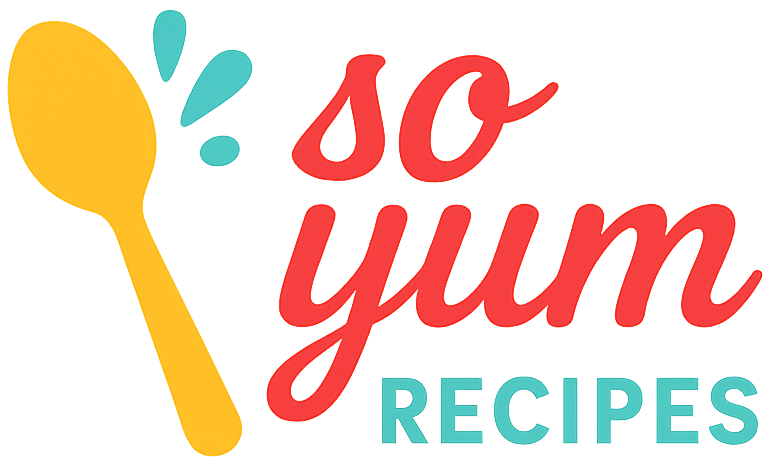Are you tired of takeout Kung Pao chicken? Look no further. In this post, I’ll guide you in making a mouth-watering version right at home. With cubed chicken thighs, vibrant peppers, and crunchy peanuts, my recipe uses simple sauces to pack flavor. Plus, I’ll share tips for customizing this dish to meet your tastes. Get ready to impress your friends and family with your amazing cooking skills!
Ingredients
Main Ingredients
– 1 lb boneless, skinless chicken thighs, cubed
– 1 red bell pepper, diced
– 1 green bell pepper, diced
– 1/2 cup diced zucchini
– 1/2 cup unsalted roasted peanuts
I love using chicken thighs for this dish. They stay juicy and tender when cooked. The fresh peppers and zucchini add color and crunch. Roasted peanuts bring a nice nutty flavor and a satisfying crunch.
Sauces and Seasonings
– 2 tablespoons soy sauce
– 1 tablespoon hoisin sauce
– 1 tablespoon rice vinegar
– 1 tablespoon cornstarch
– 1 teaspoon sesame oil
– 1 tablespoon chili paste (adjust for spice preference)
The soy sauce gives a rich umami taste. Hoisin sauce adds sweetness, while rice vinegar brings balance. Cornstarch helps thicken the sauce, making it stick to the chicken. Sesame oil adds a nutty aroma, and chili paste gives that spicy kick.
Cooking Oil and Seasoning
– 3 tablespoons vegetable oil
– Salt and pepper to taste
Use vegetable oil for stir-frying. It has a high smoke point and doesn’t overpower the dish. Season with salt and pepper to enhance flavors. Adjust to match your taste.
Gather these ingredients to make a Kung Pao Chicken that is better than takeout. Each component adds to the overall taste and texture. Enjoy the process of creating this delightful dish!
Step-by-Step Instructions
Marinating the Chicken
To start, you need to mix the marinade. In a bowl, combine the cubed chicken thighs, soy sauce, hoisin sauce, rice vinegar, cornstarch, and sesame oil. This mix adds flavor and helps the chicken stay juicy. Let the chicken marinate for at least 20 minutes. If you have more time, marinating for 1 hour works even better.
Cooking the Chicken
Next, heat 2 tablespoons of vegetable oil in a large skillet or wok over medium-high heat. Once the oil is hot, add the marinated chicken. Stir-fry it for 5 to 7 minutes until it turns golden and is fully cooked. Make sure there’s no pink inside. Once done, remove the chicken from the pan and set it aside.
Preparing the Vegetables
In the same skillet, add 1 tablespoon of vegetable oil. Toss in the minced garlic and grated ginger. Sauté them for about 30 seconds until they smell great. Then, add the diced red and green bell peppers and zucchini. Stir-fry these veggies for about 3 to 4 minutes. You want them to be tender but still a bit crunchy for a nice texture.
Combining Ingredients
Now it’s time to bring everything together. Return the cooked chicken to the skillet. Stir in the chili paste and roasted peanuts. Mix everything well. Let it cook together for another 2 to 3 minutes. This helps all the flavors blend.
Final Touches
Just before you serve, toss in the chopped green onions. Mix everything evenly. Taste and adjust the seasoning with salt and pepper as needed.
Tips & Tricks
Selecting the Right Chicken
– Use boneless, skinless chicken thighs. They stay juicy and tender when cooked.
– Marinate the chicken for at least 20 minutes. This gives it great flavor. Mix soy sauce, hoisin sauce, rice vinegar, cornstarch, and sesame oil for the best taste.
Vegetable Variations
– You can add or swap vegetables. Try snap peas, carrots, or broccoli.
– Keep the veggies crunchy. Stir-fry them for just a few minutes. You want them tender but not mushy.
Heat Level Adjustment
– Adjust the chili paste to fit your spice level. Start with less if you prefer mild.
– For a milder flavor, use sweet chili sauce instead of spicy paste. It adds flavor without the heat.

Variations
Vegetarian Kung Pao
You can make a tasty vegetarian version of Kung Pao. Instead of chicken, use tofu or tempeh. Both options soak up flavors well. For extra protein, try chickpeas or edamame.
To keep the flavor similar, use the same sauces. Soy sauce, hoisin sauce, and rice vinegar are key. You can also add more veggies like mushrooms or carrots. This adds texture and flavor without losing the dish’s essence.
Low-Carb Version
For a keto-friendly Kung Pao, substitute chicken with cauliflower. This keeps the dish light and low in carbs. Use a mix of chicken and cauliflower for a balance.
Adjust the cooking method slightly. Sauté cauliflower until tender before adding chicken. This ensures everything cooks evenly. You can also use coconut aminos instead of soy sauce. It’s low in carbs and still packs great flavor.
Regional Variations
Kung Pao is popular in many cultures, each with its twist. In Sichuan, they use more spicy peppers. The heat level can vary based on where you eat it.
Some regions add different nuts, like cashews or almonds, instead of peanuts. Others may skip vegetables entirely. They focus on the meats and sauce. These differences show how one dish can change based on local tastes.
Storage Info
Refrigeration Tips
To store leftover Kung Pao chicken, place it in an airtight container. This keeps the chicken fresh and tasty. If you use a glass container, ensure it cools first. Leftovers stay good for about 3-4 days in the fridge. Always check for any off smells before eating!
Freezing Kung Pao Chicken
Freezing Kung Pao chicken is simple. First, let it cool completely. Then, place it in a freezer-safe bag or container. Remove as much air as possible to prevent freezer burn. It can last up to 2-3 months in the freezer. When ready to eat, thaw it overnight in the fridge. Reheat it in a skillet over medium heat until hot.
Reusing Leftovers
Get creative with leftover Kung Pao chicken! You can make a tasty wrap with tortillas or lettuce. Chop it up and add it to fried rice for extra flavor. You can also mix it into salads or grain bowls. This keeps meals fresh and exciting while minimizing waste.
FAQs
Can I use a different type of meat for Kung Pao Chicken?
Yes, you can use other meats. Chicken is common, but you can try shrimp, pork, or tofu. If using shrimp, cook it until it turns pink. Pork should be thinly sliced for quick cooking. Tofu needs to be firm and pressed to remove moisture. Marinate your chosen meat as you would chicken for great flavor.
What can I substitute for soy sauce?
If you need a soy sauce substitute, try tamari or coconut aminos. Tamari is a gluten-free option that tastes great. Coconut aminos is milder and slightly sweet. For a low-sodium choice, look for low-sodium soy sauce. These options work well without losing the dish’s flavor.
How spicy is Kung Pao Chicken typically?
Kung Pao Chicken can be quite spicy, especially with chili paste. The heat level can vary based on the amount of chili paste you use. If you prefer less heat, start with a small amount and taste as you go. You can always add more spice later if needed.
Can I make Kung Pao Chicken in advance?
Yes, you can make Kung Pao Chicken ahead of time. Cook it fully, then let it cool before storing. Place it in an airtight container in the fridge for up to three days. To reheat, use a skillet over medium heat for best results. You can also freeze it for up to a month.
Cooking Kung Pao chicken is fun and rewarding. You learned about key ingredients, like chicken and peanuts, and how to marinate properly. I shared tips for selecting chicken, adjusting spice levels, and even explored vegetarian options. Remember to store leftovers well for later meals. This dish is versatile, and you can easily switch up ingredients based on taste. With the right approach, you can make a delicious Kung Pao chicken to impress anyone at your table. Enjoy experimenting with flavors and making this dish your own!


